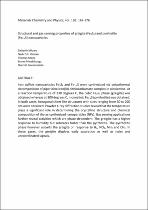 ResearchSpace
ResearchSpace
Structural and gas sensing properties of greigite (Fe3S4) and pyrrhotite (Fe1-xS) nanoparticles
JavaScript is disabled for your browser. Some features of this site may not work without it.
- ResearchSpace
- →
- Research Publications/Outputs
- →
- Journal Articles
- →
- View Item
| dc.contributor.author |
Mlowe, S

|
|
| dc.contributor.author |
Osman, NSE

|
|
| dc.contributor.author |
Moyo, T

|
|
| dc.contributor.author |
Mwakikunga, Bonex W

|
|
| dc.contributor.author |
Revaprasadu, N

|
|
| dc.date.accessioned | 2018-12-11T08:51:16Z | |
| dc.date.available | 2018-12-11T08:51:16Z | |
| dc.date.issued | 2017-09 | |
| dc.identifier.citation | Mlowe, S. et al. 2017. Structural and gas sensing properties of greigite (Fe3S4) and pyrrhotite (Fe1-xS) nanoparticles. Materials Chemistry and Physics, vol. 198: 167-176 | en_US |
| dc.identifier.issn | 0254-0584 | |
| dc.identifier.issn | 1879-3312 | |
| dc.identifier.uri | http://dx.doi.org/10.1016/j.matchemphys.2017.06.012 | |
| dc.identifier.uri | https://www.sciencedirect.com/science/article/pii/S0254058417304534 | |
| dc.identifier.uri | http://hdl.handle.net/10204/10589 | |
| dc.description | Copyright: 2017 Elsevier. Due to copyright restrictions, the attached PDF file only contains the abstract of the full text item. For access to the full text item, please consult the publisher's website. | en_US |
| dc.description.abstract | Iron sulfide nanoparticles Fe3S4 and Fe1-xS were synthesized via solvothermal decomposition of piperidine iron(III) dithiocarbamate complex in oleylamine. At a reaction temperature of 230 °C, the cubic Fe3S4 phase (greigite) was obtained whereas at 300 °C, monoclinic Fe1-xS (pyrrhotite) was obtained. In both cases, hexagonal sheet like structures with sizes ranging from 50 to 200 nm were obtained. Powder X-ray diffraction studies reveal that the temperature plays a significant role in determining the crystalline structure and chemical composition of the as-synthesized nanoparticles (NPs). Gas sensing applications further reveal activities which are phase-dependent. The greigite has a higher response to humidity but saturates faster than the pyrrhotite. The pyrrhotite phase however outwits the greigite on response to H2, NO2, NH3 and CH4. In these gases, the greigite displays early saturation as well as noisy and uncoordinated signals. | en_US |
| dc.language.iso | en | en_US |
| dc.publisher | Elsevier | en_US |
| dc.relation.ispartofseries | Worklist;21393 | |
| dc.subject | Iron sulfide | en_US |
| dc.subject | Greigite | en_US |
| dc.subject | Pyrrhotite | en_US |
| dc.subject | Gas sensor | en_US |
| dc.title | Structural and gas sensing properties of greigite (Fe3S4) and pyrrhotite (Fe1-xS) nanoparticles | en_US |
| dc.type | Article | en_US |
| dc.identifier.apacitation | Mlowe, S., Osman, N., Moyo, T., Mwakikunga, B. W., & Revaprasadu, N. (2017). Structural and gas sensing properties of greigite (Fe3S4) and pyrrhotite (Fe1-xS) nanoparticles. http://hdl.handle.net/10204/10589 | en_ZA |
| dc.identifier.chicagocitation | Mlowe, S, NSE Osman, T Moyo, Bonex W Mwakikunga, and N Revaprasadu "Structural and gas sensing properties of greigite (Fe3S4) and pyrrhotite (Fe1-xS) nanoparticles." (2017) http://hdl.handle.net/10204/10589 | en_ZA |
| dc.identifier.vancouvercitation | Mlowe S, Osman N, Moyo T, Mwakikunga BW, Revaprasadu N. Structural and gas sensing properties of greigite (Fe3S4) and pyrrhotite (Fe1-xS) nanoparticles. 2017; http://hdl.handle.net/10204/10589. | en_ZA |
| dc.identifier.ris | TY - Article AU - Mlowe, S AU - Osman, NSE AU - Moyo, T AU - Mwakikunga, Bonex W AU - Revaprasadu, N AB - Iron sulfide nanoparticles Fe3S4 and Fe1-xS were synthesized via solvothermal decomposition of piperidine iron(III) dithiocarbamate complex in oleylamine. At a reaction temperature of 230 °C, the cubic Fe3S4 phase (greigite) was obtained whereas at 300 °C, monoclinic Fe1-xS (pyrrhotite) was obtained. In both cases, hexagonal sheet like structures with sizes ranging from 50 to 200 nm were obtained. Powder X-ray diffraction studies reveal that the temperature plays a significant role in determining the crystalline structure and chemical composition of the as-synthesized nanoparticles (NPs). Gas sensing applications further reveal activities which are phase-dependent. The greigite has a higher response to humidity but saturates faster than the pyrrhotite. The pyrrhotite phase however outwits the greigite on response to H2, NO2, NH3 and CH4. In these gases, the greigite displays early saturation as well as noisy and uncoordinated signals. DA - 2017-09 DB - ResearchSpace DO - 10.1016/j.matchemphys.2017.06.012 DP - CSIR KW - Iron sulfide KW - Greigite KW - Pyrrhotite KW - Gas sensor LK - https://researchspace.csir.co.za PY - 2017 SM - 0254-0584 SM - 1879-3312 T1 - Structural and gas sensing properties of greigite (Fe3S4) and pyrrhotite (Fe1-xS) nanoparticles TI - Structural and gas sensing properties of greigite (Fe3S4) and pyrrhotite (Fe1-xS) nanoparticles UR - http://hdl.handle.net/10204/10589 ER - | en_ZA |





